Letters from Lodi
An insightful and objective look at viticulture and winemaking from the Lodi
Appellation and the growers and vintners behind these crafts. Told from the
perspective of multi-award winning wine journalist, Randy Caparoso.
At this year’s ZAP celebration in San Francisco, Zinfandel lovers will find more “grown-up” wines
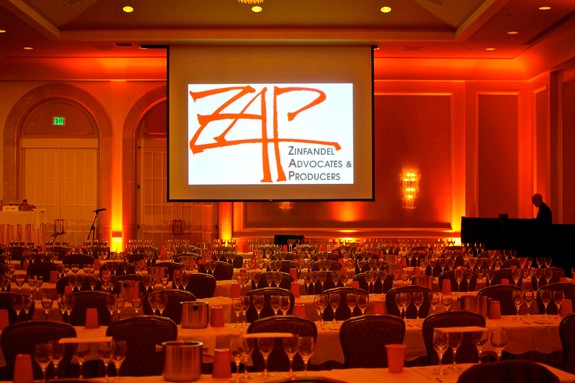
Room set for ZAP's annual Flights! tasting in San Francisco
This week – on January 17-19, 2019 – marks the annual San Francisco celebration of Zinfandel put on each year by ZAP (Zinfandel Advocates & Producers). Not every producer of California Zinfandel will be there, but most of them will be, and Zinfandel lovers will have an opportunity to taste and compare from among the very best.
One question, which inevitably comes up whenever there is a big exposition focused on one varietal category: How are California Zinfandels tasting these days?
Then there is the other question, pertinent to us in Lodi Viticultural Area, which is: How do Lodi grown Zinfandels stack up against other California Zinfandels these days?
In respect to the first question, we can probably say this: Zinfandel is evolving in similar fashion as other wine varietals grown in the U.S. There was a time, during 1960s and ‘70s, when virtually all commercial Zinfandels were grown and produced pretty much the same way – grapes picked around 22° or 22.5° Brix (i.e. sugar reading), fermented dry to about 12% or 12.5% alcohol, and aged in either American oak barrels (often the same kind of barrels used to age bourbon whiskey) or neutral containers (such as old redwood tanks) to produce zesty, light to medium bodied red wines. These were not terribly complex wines, but neither were they meant to be.
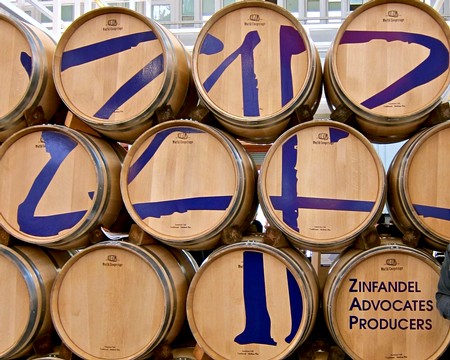
ZAP barrel-banner
Towards the late ‘70s and into the ‘80s, a few of the more influential Zinfandel producers began picking their grapes at a much riper stage, often as high as 28° or 30° Brix, and aging them in higher quality barrels – either American oak coopered in classic French fashion, or in more expensive French oak (which impart “toastier” but more subtle vanillin qualities). This produced more opulent styles of Zinfandel – often with the “jammy” fruit qualities now often associated with the varietal – typically finished as high as 16% alcohol. “Big” wines. Or as one famous winery motto goes, “No wimpy wines.”
By the 1990s and early 2000s, 15%-plus alcohol Zinfandels became the industry standard. It reached the point where, even today, 14.5% alcohol is considered a “light” style of Zinfandel, and 12.5% or 13% alcohol is practically unheard of. Oh, the latter styles exist, but those who do make them are now considered the outliers – the kooky contrarians or iconoclasts.
But here’s the thing: It’s not just Zinfandel that has evolved this way. Those who say they don’t like Zinfandels in general because they are “high in alcohol” and “overripe in fruit” are just fooling themselves. Over the past 20 years, wines made from grapes like Cabernet Sauvignon, Merlot, Syrah and Chardonnay have gone in the same direction, where 15%-plus alcohol has become the industry standard – largely, because these are the wines that get the highest “scores,” which help sell the wines – and 12.5% or 13% is practically unheard of. Even American Pinot noir – which is supposed to be a more refined wine by nature of the varietal – is now typically in the 14.5% to 15% range. It is what it is, mostly because this is just the way consumers, and wine critics, seem to like them.
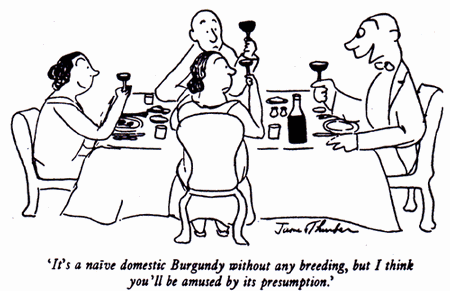
One of James Thurber's most famous cartoons (The Thurber Carnival, 1945) reflecting the state of circa-1940s American wine
Until, that is, recently. The proverbial pendulum, as it always seems to do, finally seems to be swinging back in the other direction. In an article published just this past January 13, 2019 in Great Northwest Wine, president/CEO and longtime wine journalist Eric Degerman solicited some interesting comments by another veteran wine journalist, Mike Dunne (long associated with Sacramento Bee), who had just finished up four days serving as a wine judge for the gi-normous San Francisco Chronicle Wine Competition.
Commenting on the hundreds of wines he had just tasted earlier this month, Dunne was quoted to say: “Among the best-of-class wines, the biggest trends probably would be the dialing back of oak... leaner overall, although there were still some that were very ripe and husky and fat. There is less sugar and more dryness coming through. Overall, there’s just more finesse and kind of a drifting away from being fixated on the ‘international style’ – something that would be representative of Cabernet or Merlot any place.”
Although Dunne, of course, is speaking about American wines in general, you can apply this same observation to what many Zinfandel lovers have been noticing only within the past few years at ZAP’s annual Zinfandel extravaganza. Zinfandels are getting "leaner" and, slowly but surely, more differentiated, seeking less uniformity. You can also add this comment by Dunne: “Vintners are taking more seriously an attempt to reflect a wine’s sense of place... I haven’t done any comparative figures yet, but it seemed there were far more vineyard-designated wines and wines from smaller appellations in the best of class.”
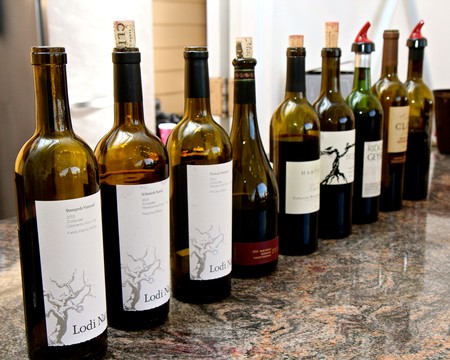
Terroir-focused Lodi Native Zinfandels poured at a recent ZAP celebration
And that’s another thing California Zinfandel lovers will find at the 2019 ZAP tastings: Not just more and more vineyard-designate bottlings, but also a little more attempt on the part of wineries to produce Zinfandels that taste more of their vineyard source than, say, their “house” style or as much alcohol and jammy fruit that they can possibly squeeze into a bottle.
We’re not saying it still doesn’t happen (because it does), but not too long ago it was more common to find Zinfandel specialists producing three, four or more vineyard-designate wines that all tasted pretty the same because of their big, overripe qualities and the aggressive stamp of whatever type of oak barrels that producer happens to like. But today, you are more likely to find finer delineations between vineyard-designate bottlings by the same producers, depending upon the grape source. This is happening mostly because vintners are showing more restraint in their picking decisions, thus ending up with wines showing vineyard-related subtleties that used to be buried under the preponderance of ultra-ripe fruitiness, excess alcohol and oak.
As Dunne also commented on the overall state of American wines in general: “Acidity levels were not nearly as flabby as some of them have been in the past... A higher percentage of the wines this year seemed like they would work at the dinner table better than they have in the past – and not being cocktail wines.”
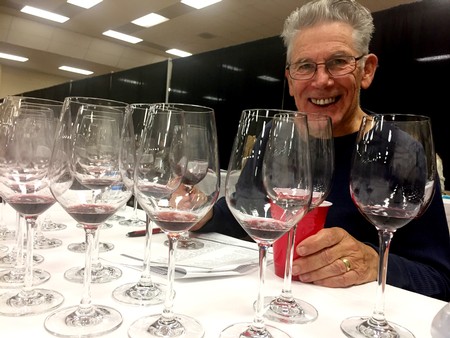
Mike Dunne at 2019 San Francisco Chronicle Wine Competition (photo by Eric Degerman, courtesy of Great Northwest Wine)
If you prefer contemporary style Zinfandels produced in this fashion, this is especially good news because, for the longest time (well, at least during the past 20, 30 years), many wine lovers were saying that you can’t drink American Zinfandel with food because it’s too alcoholic and fruity. Frankly, we’ve never thought much of that diagnosis, since even the biggest, riches Zinfandels go great with many kinds of food, thank you. Take any kind of barbecue, which is its own food group in the good ol’ U.S. of A.: Zinfandels have always been able to outperform any wine in this important food context (sorry, Pinot noir lovers, but that’s just the way it is).
But what of Lodi appellation Zinfandels? Lodi, you can say, has always been in a funny position. The region crushes about 40% of the entire state’s yearly production of Zinfandel, yet it has only been within the past 10 or so years that certain brands have come to be considered among California’s “best.” Naturally, wine regions like Sonoma County and Napa Valley enjoy well-established reputations for producing stellar Zinfandel, and it is well deserved. Although you can also find vines as old as 75 or over 100 years in parts of Paso Robles, Amador County, Mendocino and Contra Costa County – and for Zinfandel (unlike most varieties), the existence of old vines is indicative of appellations very conducive to premium quality Zinfandel production – these regions are also beginning to forge solid reputations for top quality Zinfandel.
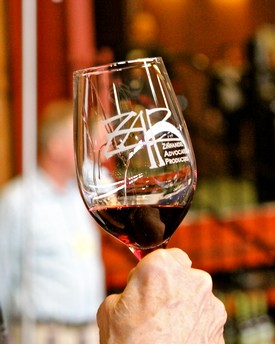
Today, Lodi has three things going for it:
1. Although much of Lodi’s Zinfandel still ends up in “value priced” bottlings (what we used to call “jugs”), many of which don’t even say “Lodi” on the label, more and more smaller wineries (what used to be called “boutiques”) are producing Lodi appellation Zinfandels following the same artisanal, handcraft protocols as top producers in places like Sonoma County and Napa Valley. Most of this has happened only within the past 15 years.
2. Many of Lodi’s best vineyards are now being recognized in vineyard-designate bottlings – something that didn’t even exist until the mid-‘90s
3. Many of these premium quality Lodi Zinfandels are now being dialed into exactly what makes a Lodi grown Zinfandel different from (as opposed to “just-as-good-as”) Zinfandels from, say, a Napa, Sonoma or Amador. Lodi Zinfandels, in other words, no longer need be compared to Zinfandels from other regions in order to be respected. It is more important to taste like Zinfandel that comes from Lodi, which can’t be compared to anywhere else, for the same reason apples aren't compared to oranges.
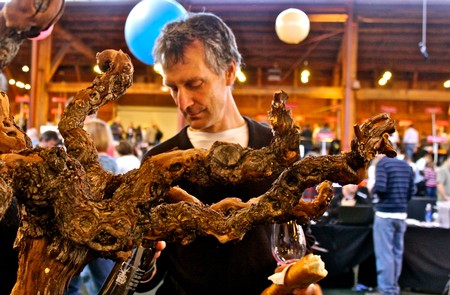
Zinfandel lover at ZAP's annual "Grand Tasting in San Francisco
If anything, it’s become increasingly clear that a Lodi grown Zinfandel crafted truer to its terroir, or “sense of place,” is one that is fruit-forward in a floral sort of way, soft or moderate in tannin (giving a round, plush feel), and even “delicate” when compared to those of other regions. Earthiness, in a loamy/organic sort of way, is also not unusual in Lodi grown Zinfandel (particularly those from vineyards on the west side of town). This is particularly good because it falls into trending consumer tastes. If you never liked a big, jammy/opulent, thick and hard-hitting style of Zinfandel, the kinder, more gentle and demure, floral style of Zinfandel crafted truer to the terroir of Lodi may be the varietal style for you!
When all is said in done, as Dunne points out, it is a matter of producers finally “dialing back” on everything – the oak, the alcohol or the sweetness in terms of sensory qualities, but also the unrestrained pursuit of some sort of varietal intensity regardless of regional or vineyard identity, or “sense of place.”
The finest wines in the world, after all, are never really those that are bigger, riper or oakier than thou. It shouldn't be a "contest." These are wines that are comfortable in their own skins, tasting indubitably of themselves – where they are grown, which is what they ought to taste like. In that sense, is California Zinfandel, and Lodi Zinfandel in particular, finally growing up? All signs are showing that, if anything, this evolution is finally in the air!
Iconically "Lodi": 118-year-old vine in Lodi's Marian's Vineyard
